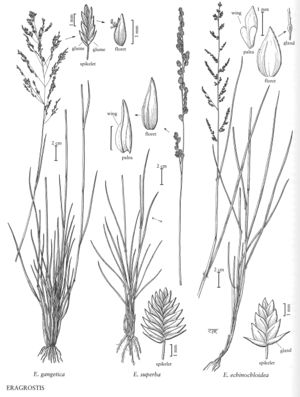Difference between revisions of "Eragrostis gangetica"
FNA>Volume Importer |
FNA>Volume Importer |
||
| Line 7: | Line 7: | ||
|synonyms={{Treatment/ID/Synonym | |synonyms={{Treatment/ID/Synonym | ||
|name=Eragrostis stenophylla | |name=Eragrostis stenophylla | ||
| − | |authority= | + | |authority= |
| + | |rank=species | ||
}} {{Treatment/ID/Synonym | }} {{Treatment/ID/Synonym | ||
|name=Eragrostis flamignii | |name=Eragrostis flamignii | ||
| − | |authority= | + | |authority= |
| + | |rank=species | ||
}} | }} | ||
|hierarchy=Poaceae;Poaceae subfam. Chloridoideae;Poaceae tribe Cynodonteae;Eragrostis;Eragrostis gangetica | |hierarchy=Poaceae;Poaceae subfam. Chloridoideae;Poaceae tribe Cynodonteae;Eragrostis;Eragrostis gangetica | ||
| Line 23: | Line 25: | ||
-->{{Treatment/Body | -->{{Treatment/Body | ||
|distribution=Fla.;Miss.;La. | |distribution=Fla.;Miss.;La. | ||
| − | |discussion=<p>Eragrostis gangetica is an Asian species that now grows in the southeastern United States. It can be found in the sandy margins of ponds, roadsides, and ditches, at 0-100 m, usually in association with Pinus, Taxodium distichum, Rynchospora, and Steinchisma hians. Eragrostis gangetica is similar to E. bahiensis, but differs from that species in its annual habit and shorter spikelets, lemmas, anthers, and caryopses.</p> | + | |discussion=<p><i>Eragrostis gangetica</i> is an Asian species that now grows in the southeastern United States. It can be found in the sandy margins of ponds, roadsides, and ditches, at 0-100 m, usually in association with <i>Pinus</i>, <i>Taxodium distichum</i>, Rynchospora, and <i>Steinchisma hians</i>. <i>Eragrostis gangetica</i> is similar to <i>E. bahiensis</i>, but differs from that species in its annual habit and shorter spikelets, lemmas, anthers, and caryopses.</p> |
|tables= | |tables= | ||
|references= | |references= | ||
| Line 32: | Line 34: | ||
-->{{#Taxon: | -->{{#Taxon: | ||
name=Eragrostis gangetica | name=Eragrostis gangetica | ||
| − | |||
|authority=(Roxb.) Steud. | |authority=(Roxb.) Steud. | ||
|rank=species | |rank=species | ||
| Line 39: | Line 40: | ||
|basionyms= | |basionyms= | ||
|family=Poaceae | |family=Poaceae | ||
| − | |illustrator=Linda A. Vorobik | + | |illustrator=Linda A. Vorobik;Cindy Roché |
| + | |illustration copyright=Utah State University | ||
|distribution=Fla.;Miss.;La. | |distribution=Fla.;Miss.;La. | ||
|reference=None | |reference=None | ||
| Line 45: | Line 47: | ||
|publication year= | |publication year= | ||
|special status= | |special status= | ||
| − | |source xml=https:// | + | |source xml=https://jpend@bitbucket.org/aafc-mbb/fna-data-curation.git/src/f50eec43f223ca0e34566be0b046453a0960e173/coarse_grained_fna_xml/V25/V25_139.xml |
|subfamily=Poaceae subfam. Chloridoideae | |subfamily=Poaceae subfam. Chloridoideae | ||
|tribe=Poaceae tribe Cynodonteae | |tribe=Poaceae tribe Cynodonteae | ||
Revision as of 21:33, 16 December 2019
Plants annual; tufted, without innovations, without glands. Culms (12)25-75 cm, usually erect, sometimes geniculate and branched below, glabrous, reddish. Sheaths glabrous, apices usually with 0.3-2.2 mm hairs; ligules 0.2-0.4 mm, ciliate; blades (5)7-17 cm long, 1-3 mm wide, flat to folded basally, involute apically, abaxial surfaces glabrous, adaxial surfaces scabridulous, sometimes with scattered hairs near the base. Panicles (6)11-21 cm long, 1-13 cm wide, ovate to somewhat contracted, open; primary branches 0.5-12 cm, (12)15-20 per culm, appressed or diverging up to 60° from the rachises, often capillary, naked near the base; pulvini glabrous; pedicels 0.3-5 mm, mostly appressed. Spikelets 2-4.6 mm long, 0.9-2 mm wide, narrowly ovate, greenish-yellow to plumbeous and with a reddish-purple tinge, with 5-15 florets; disarticulation acropetal, paleas persistent. Glumes lanceolate to ovate, membranous; lower glumes 0.4-0.9 mm; upper glumes 1-1.3 mm, occasionally 3-veined; lemmas 1-1.3 mm, broadly ovate, membranous, often reddish-purple, lateral veins conspicuous, often greenish, apices acute; paleas 0.9-1.1 mm, hyaline, keels scabridulous, apices obtuse; anthers 2, 0.1-0.2 mm, reddish-purple. Caryopses 0.3-0.5 mm, subglobose to obovoid, not grooved, translucent, faintly striate, reddish-brown. 2n = 80.
Distribution
Fla., Miss., La.
Discussion
Eragrostis gangetica is an Asian species that now grows in the southeastern United States. It can be found in the sandy margins of ponds, roadsides, and ditches, at 0-100 m, usually in association with Pinus, Taxodium distichum, Rynchospora, and Steinchisma hians. Eragrostis gangetica is similar to E. bahiensis, but differs from that species in its annual habit and shorter spikelets, lemmas, anthers, and caryopses.
Selected References
None.
